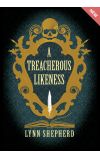
04 Mar 2013 03:28:11
Shepherd is not the first novelist to weave fantasy around the Shelleys: that distinction was claimed in 1837 by the youthful Benjamin Disraeli in Venetia. Nor is she the first commentator to have become fascinated by Mary Shelley's indomitable daughter-in-law, Jane. A Treacherous Likeness opens with Jane Shelley summoning detective Charles Maddox to the house on Chester Street from where she controls access to Shelley's archive with an iron grasp. Charles's brief is to establish what papers Claire Clairmont has in her possession and to help the Shelleys retrieve them. Being a bright young man, Charles deduces that Jane and her hen-pecked husband Sir Percy in fact want more from him than this. Over the course of much sleuthing he discovers that his own great-uncle became entangled with the Shelleys in 1814, and that in the papers of his family lies a secret which threatens to destroy the legacy of the poet and his wife.
That secret is at the heart of A Treacherous Likeness, the plot of which is largely concerned with Charles's efforts to uncover it. His researches take him all over London, from the grandeur of Chester Street to the shabby gentility of St John's Wood and the seedy lanes behind the new Waterloo railway. Shepherd is good on Victorian London, with its fogs and winds and lives lived, particularly by women, on the verge of desperation. She is also skilled at plot and pacing: this is a story which will keep you turning the pages. Her characters, too, are given depth and authenticity through neat incorporation into their conversation of snatches of letters and diary entries. Shelley's charisma is here, as well as his unpredictable moods; Claire Clairmont is infatuating and infuriating in equal measure. A scene which paints a picture of the aftermath of one of Shelley's attempts to render Claire hysterical is particularly effective, as are the portraits of Jane and Sir Percy, neatly described as a "controversially ordinary man".
Yet problems abound. Shepherd turns Romantic tragedy into Victorian melodrama, complete with a villain more unspeakable than her most famous literary creation. Others have argued that Mary Shelley lied about the authorship of Frankenstein, but few have accused her of multiple murders. That Shepherd dislikes Mary Shelley is clear, but the cloak of fiction does not absolve her of responsibility to the facts, especially not when she claims in prefatory matter that her thesis is supported by research. In her search for sensation she undermines her novel, lessening the charm of her evocation of 19th-century London with a denouement that is not only ludicrous but fundamentally misconceived and mean-spirited. There are problems, too, with a narrative style which tries to be omniscient but which feels often heavy-handed and self-referential.
Despite these problems, A Treacherous Likeness raises interesting questions about the ethical relationship between biography and fiction. Shelley is as intriguingly animated here as the figure who appears in biographies of the poet, and Shepherd is as sensitive to the cadences of Claire Clairmont's voice as more scholarly chroniclers of her life. The novel asks pertinent questions of the Shelleys' story, highlighting its complications and the drama inherent in its clash of personalities. It is, therefore, more of a pity that the answers it provides are so nasty. It is the privilege of fiction to speculate, to invent truths that documentary evidence cannot supply. But in exploring the stories of figures who are no longer able to defend themselves it is a privilege which has to be used wisely. A Treacherous Likeness forgets this. Despite its suspense-filled plot, skilful characterisation and atmospheric setting it is a lesser book as a result.

